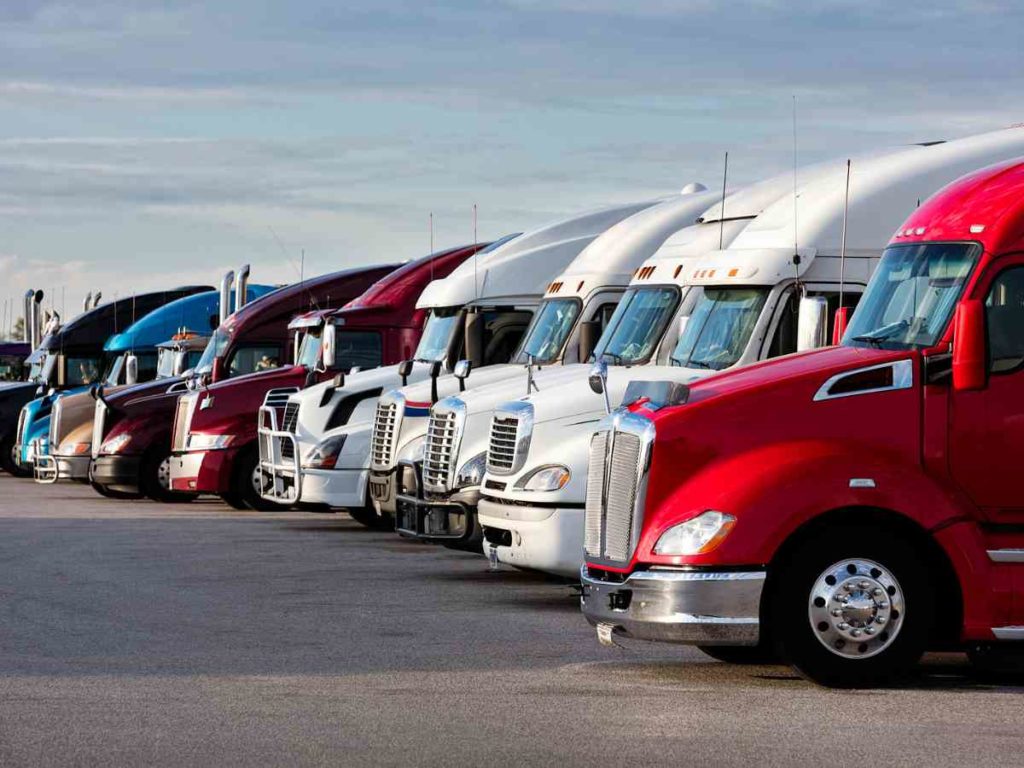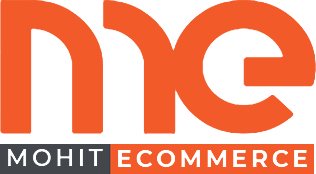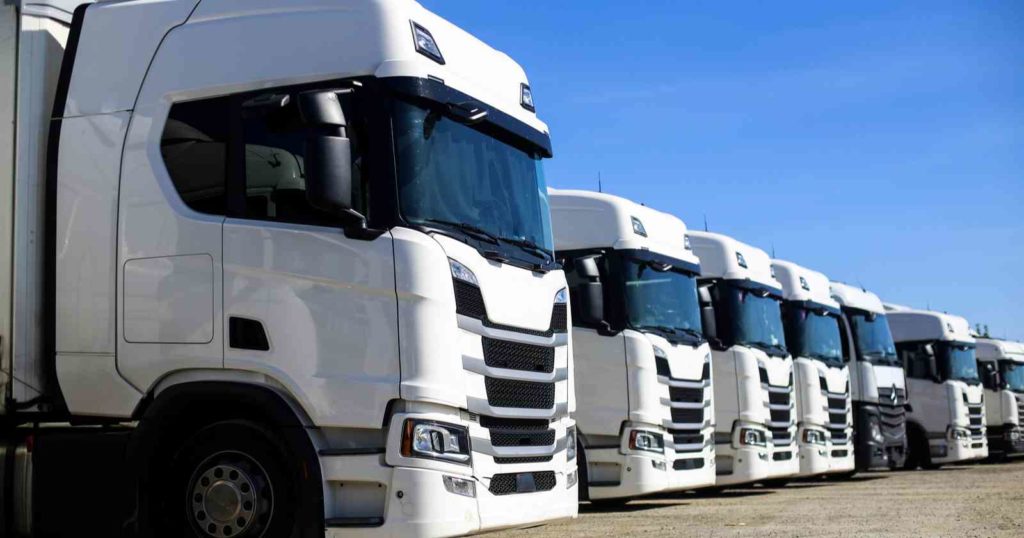What is trucking business?

Trucking business is the activity of transporting goods and materials across the world. It is a vital industry that plays a major role in the global economy. Trucking companies range from small independent operators to large multinational corporations. They are responsible for transporting goods and materials from one point to another, typically between cities, ports, and other destinations.
Truckers are highly skilled professionals who must maintain the highest level of safety while on the road. They must adhere to strict laws and regulations, as well as adhere to specific policies regarding the delivery of goods. The trucking industry is a highly competitive business and requires specialized knowledge in order to be successful.
Truckers must have an understanding of their freight needs, including loading and unloading, routing, and other related services. Additionally, they must possess a valid commercial driver’s license (CDL) in order to operate their vehicles.
With the ever-changing global economy, truckers need to stay informed about current trends and technologies that can help improve their services and efficiency. Whether you’re looking for a new career or simply want to learn more about the trucking industry, understanding what it takes to be successful can help you reach your goals.
Understanding the Trucking Industry

The trucking industry is responsible for transporting goods and services across the United States, making it a vital part of the American economy. Understanding the ins and outs of this vast industry can be difficult but the rewards are vast. To start, truckers must understand the different types of vehicles available to them and their limitations. There are heavy-duty trucks for long hauls, medium-duty trucks for shorter trips, and box trucks for smaller loads.
Each one has its own unique capabilities which must be taken into account when deciding what type of truck is best for a particular job. Truckers need to understand the different regulations governing trucking, such as hours of service and weight limits.
Staying informed about all the laws and regulations will help ensure a successful and safe trip. Furthermore, truckers must understand the importance of keeping their vehicle in good condition. Regular maintenance and inspections will keep a truck running efficiently and will help minimize unexpected breakdowns.
Truckers need to be aware of the various resources available to them along their route such as rest stops, fueling stations, and roadside assistance. By understanding the different aspects of the trucking industry, truckers can better plan and prepare for their trips and make sure they are successful ones.
How To Develop A business plan in trucking business?

Step 1 Identify the type of trucking business needed
Identifying the type of trucking business needed is a key step in getting started in the trucking industry. To determine what type of trucking venture is best for you, it’s important to consider your goals and the resources you have available. Do you want to start a business that transports goods within a certain region, or do you want to start a business that transports goods across the country?
Do you need to purchase trucks or can you lease them? Once you have thought through these questions, it will be easier to identify the type of trucking business that best suits your needs. If you are uncertain about what type of trucking business is best for you, it is wise to consult an expert in the field who can provide valuable advice.
With the right resources and knowledge, you can identify the type of trucking business that will help you reach your goals and make a success of your venture.
Step 2 Research the industry and the customer base in trucking business
Research is essential if you want to succeed in the trucking business. Understanding the industry, the customer base, and the competition is essential for success.
Knowing the needs of your customers is critical to providing the best service possible, and understanding how other companies are meeting those needs will give you a competitive edge.
You can start by doing market research to learn more about the trucking industry, such as the trends, the latest technology, and emerging markets. You should also research your customer base to get an understanding of their needs and preferences. This data can help you create a successful marketing strategy and provide better customer service.
Researching your competition can provide valuable insights into how they are operating and their overall strategy for success. Taking the time to research your industry and customer base will give you a better chance of success in the trucking business.
Step 3 Develop a financial and operational plan in trucking business
Developing a financial and operational plan for a trucking business is essential for success and long-term survival. Planning helps identify the financial needs of the business and provide guidance in making operational decisions.
The plan should include a budget, a cash flow analysis, a list of major expenses, an assessment of customer needs and an analysis of pricing. It should also include a marketing strategy and an analysis of the competition. To begin, create an outline that includes the key components of the plan.
Once you have identified the elements, gather all relevant information to fill in each section. When setting up your budget, determine how much money you need to start your business, how much you need to continue running it, and how much you will need to pay yourself.
When analyzing your pricing structure, consider factors such as overhead costs, market demand, and competition. Developing a plan for your trucking business will help you stay organized and focused on your goals. With careful planning and preparation, you can increase your chances of success in the trucking industry.
Step 4 Create a business and marketing plan in trucking business
Creating a business and marketing plan for a trucking business is essential in order to ensure that your venture is successful. A comprehensive plan should include research into the industry, analysis of market conditions, identifying target customers, setting pricing strategies, and developing a marketing strategy. To begin, you should perform an industry analysis that focuses on the trucking industry.
This analysis should include understanding current trends, consumer needs and wants, and the competition within the industry. Next, you should identify your target customers for the trucking business. Consider key demographics such as age, gender, and location. Additionally, you should examine potential customer buying habits and preferences.
Once you have identified your target customers, you should research potential pricing strategies in order to ensure that you are able to remain competitive in the industry. Lastly, develop a comprehensive marketing plan for the trucking business. This includes methods such as online marketing, direct mail campaigns, and print advertising.
A good marketing plan should be tailored to the target customers and industry conditions. By creating a business and marketing plan for your trucking business, you can ensure that it is successful and profitable.
Step 5 Estimate the startup costs and capital needed in trucking business
Starting a trucking business is an exciting endeavor, but it’s important to know the estimated costs and capital needed to get your business off the ground. To accurately estimate these costs, you must consider the size of your fleet and the type of freight you plan to haul. When calculating startup costs, you need to factor in expenses such as vehicle purchase and maintenance, insurance, licensing fees, and fuel costs.
You must consider the cost of hiring drivers, recruiting staff, and investing in technology like GPS tracking systems and dispatch software. You should also consider the capital you need to cover operational costs such as fuel, maintenance, and repairs until you start to make a profit. It’s important to develop a business plan that outlines your current financial situation and future projections to ensure that you have enough capital to cover the startup costs of your trucking business.
By taking the time to properly research and estimate the startup costs and capital needed in trucking business, you can ensure that your venture is successful and profitable.
Step 6 Draft a mission statement and company goals
Drafting a mission statement and company goals is essential for any business. It serves as a framework for how the company will develop and what it is striving to achieve. It helps to define the purpose of the business and sets expectations for everyone involved.
The mission statement should be straightforward and succinct, conveying the core values of the company and its overall purpose. Once the mission statement is established, companies can move on to setting goals that are tied to the mission statement. Goals should be clearly defined, measurable, achievable, relevant, and timely.
Achieving these goals will help a company stay on track and keep moving forward towards its mission. It is also important to evaluate progress regularly and make adjustments as needed in order to remain successful. By following these steps, businesses can create a mission statement and company goals that will help guide their growth and development.
Step 7 Register the company and obtain necessary permits for trucking business
Starting a trucking business requires you to register the company with a legal entity and obtain the necessary permits and licenses. The first step is to decide what type of business structure you want to operate as.
Depending on the structure you choose, you’ll need to register with the appropriate state agency and obtain a federal employer identification number (EIN) from the IRS. Once registered, you’ll need to apply for necessary permits, such as an interstate operating authority permit, fuel tax permits, and any other required permits. These permits will allow you to operate in multiple states and transport goods across state lines.
When applying for these permits, be sure to collect all the necessary documents and materials that need to be submitted along with your application. You may also need to provide proof of insurance and submit vehicle information as part of the application process.
Make sure that your vehicles are in compliance with local, state, and federal regulations before beginning operations. Once all the paperwork is processed and approved, you’ll be able to start your trucking business with all the necessary permits and licenses in hand.
Step 8 Acquire the necessary vehicles and equipment
When it comes to acquiring vehicles and equipment for your business, it is essential to take the time to research different options to make sure you are getting the best value for your money. It is important to consider the quality of the vehicle or equipment, its features, and the cost of ownership over time.
You should assess the potential risks associated with each option and determine the most suitable choice for your business. You may decide to purchase new vehicles and equipment, lease them, or rent them short-term. Whichever choice you make, it is necessary to consider how each option will affect your bottom line.
You should also take into account factors such as maintenance costs, fuel efficiency, and warranties when making your decision. Ultimately, ensuring you acquire the necessary vehicles and equipment can help ensure that your business operations are efficient and productive.
Step 9 Hire the right staff and personnel in trucking business
Hiring the right staff and personnel is essential for any trucking business to succeed. Properly selecting and onboarding employees can make a huge difference in the success of a company, as having the right people on board can help drive productivity and efficiency.
The key is to identify the skills, traits, and qualities that will best suit your business needs and create an effective hiring process that will enable you to hire the right people. Start by creating a job description that outlines the qualifications, experience, and other criteria you’re looking for, then use this to create a list of questions that you can use to evaluate applicants during interviews.
After an applicant has been chosen, onboarding them properly is essential to ensure they are prepared and ready to take on their role. This includes providing them with necessary training, setting expectations, and helping them understand their job duties and responsibilities. Taking the time to hire the right personnel in your trucking business can have a huge impact on its success.
Acquiring trucking equipment and vehicles in trucking business

Starting a trucking business can seem like a daunting task; however, it can be easier than you think with the right equipment and vehicles. Acquiring the right equipment and vehicles is critical for any trucking business. The first step should be to decide what type of equipment and vehicles will best suit your business needs. Consider the types of cargo you’ll be hauling, the size of the shipments, and how often you will be delivering them. Once you’ve determined what type of equipment and vehicles are necessary, you can begin researching different options.
Consider factors such as cost, features, and performance. Make sure to take into account any local and state regulations that may apply to your business. You’ll also want to research the availability of parts and services for the equipment and vehicles you purchase. Finally, choose a reliable vendor that can provide you with maintenance and repair services for your trucking equipment.
By taking the time to research your options and make an informed decision, you can ensure that your trucking business has the right equipment and vehicles for its long-term success.
Securing necessary permits and licenses

Securing necessary permits and licenses is a key step in starting a new business. Without the proper permits and licenses, businesses can face hefty fines and even closure. To make sure your business is compliant with all applicable laws, there are a few steps you should take.
Identify the permits and licenses that are required for operating your business. Different states and localities have different requirements, so it is important to do your research.
Contact the appropriate government agencies to determine the process for obtaining the necessary documents. Finally, apply for all of the necessary permits and licenses and pay any associated fees.
Once you have obtained all of the necessary permits and licenses, you can move forward with officially launching your business. Following these steps will help ensure that the process of obtaining permits and licenses goes as smoothly as possible.
Finding and hiring qualified drivers

Finding and hiring qualified drivers can be a daunting task for any business. However, it is one of the most important steps in ensuring that your company has the best resources available to succeed. The key to a successful driver search is knowing what qualities to look for in potential hires.
When evaluating candidates, look for individuals with clean driving records, excellent customer service skills, and a willingness to learn. Additionally, it is important to assess their experience in the industry and ask questions about their knowledge of regulations and safety protocols.
Consider their availability and willingness to take on additional tasks or challenges. Once you have identified a pool of qualified applicants, make sure to conduct background checks and contact references in order to verify their qualifications.
Provide an attractive compensation package that entices the right candidate to join your team. By taking these steps, you can be confident that you have found the best possible driver for your business.
Establishing partnerships with shippers and carriers
Partnering with shippers and carriers is an important step in any successful business. It helps ensure that goods and services reach their destination in a timely and cost-effective manner. Establishing these partnerships requires careful consideration of several key factors, such as the type of cargo being shipped, the route taken, and the delivery time frames. Working with the right shippers and carriers can ensure that customers receive their orders on time, while also reducing costs.
When selecting a partner, businesses should consider their reputation, experience, and rates. They should also be sure to ask for references from past or current customers to get a better idea of how reliable their services are. Additionally, businesses should be aware of any additional fees or charges associated with the service.
By taking the time to research and evaluate potential partners, businesses can ensure that they are making the best decision for their company.
How To Develop a dispatch and logistics system in trucking business?
Step 1 Research transport regulations
Researching transport regulations doesn’t have to be a daunting task. With the right resources, you can quickly learn about the latest rules and regulations and make sure you’re compliant. The first step is to identify the regulations relevant to your particular industry.
You can usually find this information on your state or federal government’s websites, or from industry associations. Once you know what rules you need to follow, you should research them thoroughly to ensure that you understand all the requirements.
This might include reading through government documents, attending seminars or webinars, or consulting with an industry expert. It’s also important to stay up-to-date on any changes in the regulations, as this can affect your business operations. Finally, it’s essential to put systems in place to ensure that you’re adhering to the rules and regulations at all times.
By taking the time to research and implement transport regulations, you can ensure that your business will remain compliant and successful.
Step 2 Develop a dispatch system that can track cargo
Developing a dispatch system that can track cargo is essential for businesses in the transportation industry. It provides a way to monitor shipments from the moment they leave the warehouse until they are delivered to the customer. The system can be used to ensure that shipments are on time and that customers receive accurate information about their packages.
By using a dispatch system, businesses can also save time and money by avoiding unnecessary trips and re-dispatching of packages. Additionally, it allows businesses to keep track of the cargo’s location, monitor its progress, and even create reports with details about its status.
This information can be used to improve customer service, manage inventory more accurately, and identify any potential issues before they become a problem. With this type of system in place, businesses can ensure that their cargo is delivered safely and efficiently.
Step 3 Optimize routes to reduce fuel usage and costs
Optimizing routes is a great way to save money on fuel costs and reduce environmental impact. It can be difficult to know where to start when it comes to optimizing routes, but there are a few simple steps you can take.
Plan your route in advance. Knowing exactly where you need to go and how you will get there will help you avoid unnecessary detours that waste fuel. Second, consider taking public transportation or carpooling with friends or colleagues whenever possible. Not only is this a great way to reduce fuel usage and costs, but it can also be more convenient and enjoyable. Third, use navigation tools or apps that can provide real-time traffic updates so you can find the most efficient route. Finally, minimize idling time by avoiding rush hour traffic and plan rest stops accordingly.
By following these simple steps, you can optimize routes to reduce fuel usage and costs while also reducing your environmental impact.
Step 4 Invest in a good transportation management system
Are you looking to invest in a good transportation management system? If so, you’re in luck! Investing in a good transportation management system can help your company save time, money, and effort. It can help you streamline processes, reduce costs, and improve customer service.
With a good transportation management system, you’ll be able to plan routes in the most efficient way, track shipments, and manage inventory. You’ll be able to provide better customer service by tracking shipments and responding quickly to customer inquiries.
It will also help you save time by automating processes and reducing paperwork. Investing in a good transportation management system is a smart move for any business that needs to manage deliveries and shipments.
It will provide you with the tools you need to make sure that your deliveries are on time and that your customers are satisfied with their orders. Invest in a good transportation management system today and start saving time, money, and effort!
Step 4 Streamline delivery processes with automated software
Automation software is the perfect solution for streamlining delivery processes. It can reduce human error and help you avoid costly mistakes. Automation software can save businesses time and money by reducing manual data entry and making sure all information is accurate.
It also eliminates tedious and repetitive tasks, freeing up employees to focus on more important tasks. Automation software can also help with tracking deliveries, making sure orders are delivered on time and meeting customer expectations.
Automated software can ensure that all customer data is securely stored, protecting businesses from potential security breaches. Automation software is a great way to simplify delivery processes while providing customers with a better experience. With the right automation software, businesses can benefit from improved efficiency, cost savings, and better customer satisfaction.
Step 5 Train staff on how to use the system
Training staff on how to use the system is essential for any business. It ensures that everyone is on the same page and knows how to properly utilize the system. An effective training program should start with an overview of the system. This should include an introduction to the features and functionality available. After that, it is important to demonstrate how to use the system, including navigating menus, inputting data, and running reports.
Once staff has had time to practice using the system, review sessions can be conducted to ensure that everyone understands how to use the system.
Providing ongoing support and refresher courses helps to ensure staff are comfortable using the system. Setting up a training program for your staff on how to use the system will help ensure smooth operations and efficient use of resources.
Step 6 Integrate the system with customer’s systems
Integrating your system with customers’ systems can be a powerful way to improve customer experience and achieve more efficient operations. It can help you streamline processes, reduce overhead costs, and provide customers with the convenience of a single integrated system. To get started, you’ll need to consider the technical requirements and ensure that your system is compatible with the customer’s. After that, you’ll need to plan how the data will be exchanged, managed, and secured. Finally, you’ll need to test the integration to make sure it works properly.
Once everything is in place, you’ll be able to benefit from improved customer service, better performance, and fewer technical issues. With careful planning and attention to detail, integrating your system with customers’ systems can be a great way to drive business success.
Step 7 Monitor performance regularly and make necessary adjustments
Monitoring performance regularly is an integral part of running a successful business. It gives you an understanding of how employees, processes, and products are performing, enabling you to make any necessary adjustments.
To ensure accurate performance tracking, make sure to use reliable data sources and set goals that are specific and measurable. Start by measuring overall performance and then break it down into smaller components. Once the data is collected, analyze it to uncover any trends or patterns.
This will enable you to identify areas for improvement and make the necessary changes. It’s important to remember that regular performance monitoring is a continuous process—you should evaluate progress regularly to ensure that your goals are still being met. If you find that your current strategies are not working as expected, don’t be afraid to make adjustments and try something new. By regularly monitoring performance and making changes where needed, you can ensure the success of your business.
Maintaining compliance with federal regulations and standards
Maintaining compliance with federal regulations and standards is essential for any business to remain in good standing. It’s important to understand the regulations and standards, as well as take the necessary steps to stay compliant. Depending on the industry, there may be a variety of applicable regulations and standards. It’s important to check regularly for any changes or updates to these regulations and standards.
Businesses should also have processes in place to ensure compliance with all applicable standards, such as having an internal audit team or working with an outside agency to conduct regular reviews.
Staying up-to-date on the most recent government initiatives is key for staying compliant, as new regulations and standards may be introduced that businesses need to be aware of. Implementing training sessions for staff members is also beneficial to ensure that they are aware of the regulations and standards, and how they can remain compliant.
Document retention is important as it can help prove that a business has been compliant with all applicable regulations and standards if ever required. Taking these steps will not only help a business remain compliant with federal regulations and standards, but it can also help protect a business from potential legal issues.
Marketing and Advertising Strategies
In order to be successful in today’s competitive business environment, it is essential to have an effective marketing and advertising strategy.
Developing an effective strategy requires having a clear understanding of the target market and their wants and needs. It is also important to have a well-defined budget for the marketing and advertising efforts. Additionally, it is important to consider the various platforms available to reach the target market, such as television, radio, print, digital, and social media.
Once the target market and platform are identified, it is important to determine how best to communicate with them. This includes defining the message, choosing the right visuals, and optimizing for search engine results.
Companies should also consider using influencers as part of their marketing and advertising efforts to reach a larger audience. Lastly, companies should track their results over time to ensure their efforts are successful. With a thoughtful plan in place, companies can create an effective marketing and advertising strategy that will help them reach their goals.
Staying up to date with industry trends and technology advancements
Staying up to date with industry trends and technology advancements can provide a significant competitive edge for any business. Keeping tabs on the latest developments in your industry can help you stay ahead of the curve and identify potential opportunities. To stay informed, make sure to regularly read industry-specific publications and blogs, follow key influencers on social media, and attend relevant seminars and training sessions. Furthermore, subscribing to newsletters and podcasts related to your sector can help you stay updated on the latest news.
Actively participating in online discussion forums or attending workshops can further enhance your knowledge. Finally, investing in a good CRM system can also help you stay organized and keep track of important contacts and leads.
By taking these necessary steps, you can ensure that your business always has the tools and resources necessary to stay on top of industry trends and technology advancements.

